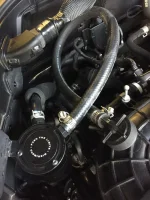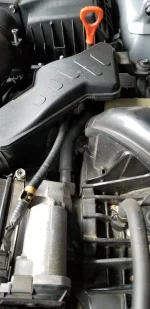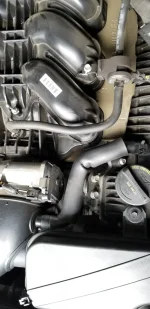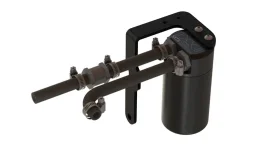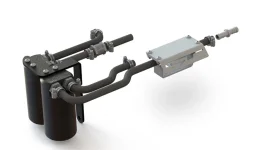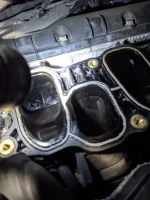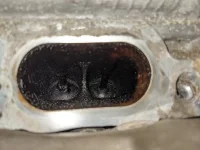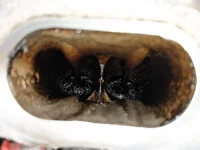I finally got around to documenting the Oil Can Collection (OCC)/ PCV Catch Can install I did at 3,700 miles April 2018 on my 2018 G80 Sport AWD (3.3L TT V6).
My requirements for deciding how to install this were.
R1) No modifications in engine compartment (i.e. No new drill holes)
R2) Easily removable. Dealer suggested I remove this whenever I bring it for service to avoid warranty claims being denied.
R3) Easily accessible for draining tank without removing entire assembly.
Total Cost $113.72USD (plus some minor items already had).
It took about 1 hour of work (not counting waiting 2 coats of spray paint to dry).
Parts
P1) Oil Catch Can - Mishimoto MMBCC-MSTWO-BK Black Compact Baffled 2-Port Oil Catch Can
Amazon $95.74USD
This one has an air diverter which should help oil separation.
It also has a 50 micron filter in the output side which should help particles and oil from being pulled into the manifold.
The purchased OCC has a smaller capacity than most catch cans. Based on 4,000 miles I should be able to empty it at my 5,000 mile oil change without worry of it reaching capacity (I'm still going to check it every 1,000 miles though

.
I did not want the oil level clear glass indicator. I had heard they are prone to leaking.
P2a) 2 x Galvanize Steel Angle $1.30 each.
P2b) 2 x small bolts to attach steel angle brackets together ((I had these laying around the house).
P3) 2 x Radiator hose clamps (I had these laying around the house).
P4) 3 feet transmission hose (NAPA Estimated $5.00USD).
Inside diameter 0.5 inch (This critical for the fit. Take one of the plastic fittings when you purchase the hose).
Outside 0.8 inch diameter (not critical).
P5) Rust-Oleum High Performance Enamel spray paint (to paint bracket). $5.27USD.
P6) Chore Boy Stainless Steel Scrubber $5.11USD.
This will enhance oil collection within OCC.
P9) Thin unshielded/bare copper wire. (I had this laying around the house).
This is used to attach the stainless steel scrubber to the OCC air diverter.
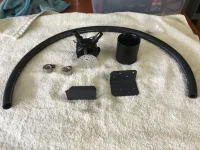 Assembly
Assembly
Install location
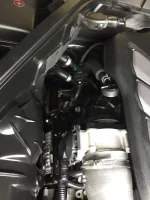
A1) Attach Stainless Steel scrubber to underside of OCC air diverter (silver/aluminum plate) with thin copper wire.
Trim the scrubber to fit within the can. Ensure there are no loose pieces.
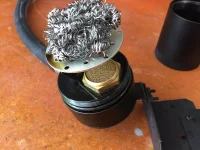
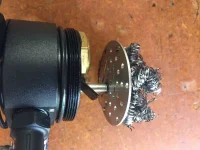
A2) Assemble mounting bracket.
Bolt steel angle brackets together offset per picture below.
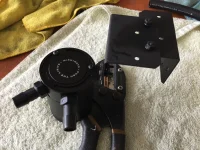
Drill holes in assembled angle bracket to mount to OCC bracket.
Paint assembled angle bracket.
Remove existing 10mm bolt near +/positive side of "battery cover". I know the batter is actually in the trunk.
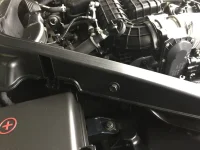
Test fit assembled bracket and mark hole to drill in assembled bracket based on existing vehicle bolt.
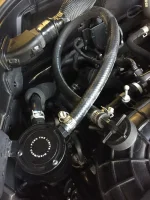
Drill mounting hole (0.25 inch) in assembled angle bracket
Mount OCC bracket to angle bracket.
Adjust the mount bracket on the OCC to orient the hose fittings correctly.
A3) Cut transmission hose to 28"
Connect one end to RIGHT OCC fitting (looking from top off OCC).
A4) Disconnect vehicles PCV host from intake manifold and mount to LEFT OCC fitting (looking from top off OCC).
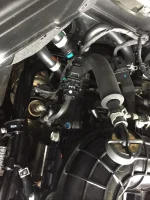
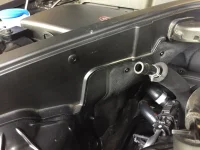
Connect end of OCC output hose (new hose) to manifold.
A4) Add some tape to the inside of the new assembled angled bracket to protect from scratching the engine interior plastic.
Mount new assembled angled bracket with existing 10mm bolt removed above..
Things I'd change/do differently
C1) The bracket is ugly. I may replace with a color matching custom made bracket when I get time.
C2) The OCC is mounted above one of the turbo chargers. I considered the turbo charger heat may cause the collected oil to vaporize and get sucked into the manifold. I've seen some people mount the OCC to the firewall, but this makes it a little less accessible for draining and I did not want to drill a hole in the engine compartment.
C4) I'd use a glossier black for the bracket. The matte black does not match the engine compartment color.
I was collecting about 3.0 ml / 0.1 fl-oz per 500 miles. This was kinda low compared to others reports in this forum. I did check the output side hose of the OCC and it was dry/no oil (good thing). I recently (500 miles ago) added the stainless steel scrubber to the OCC. I'll monitor for increased oil collection.













